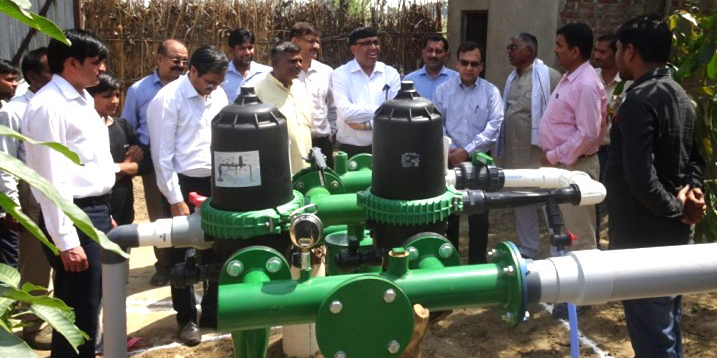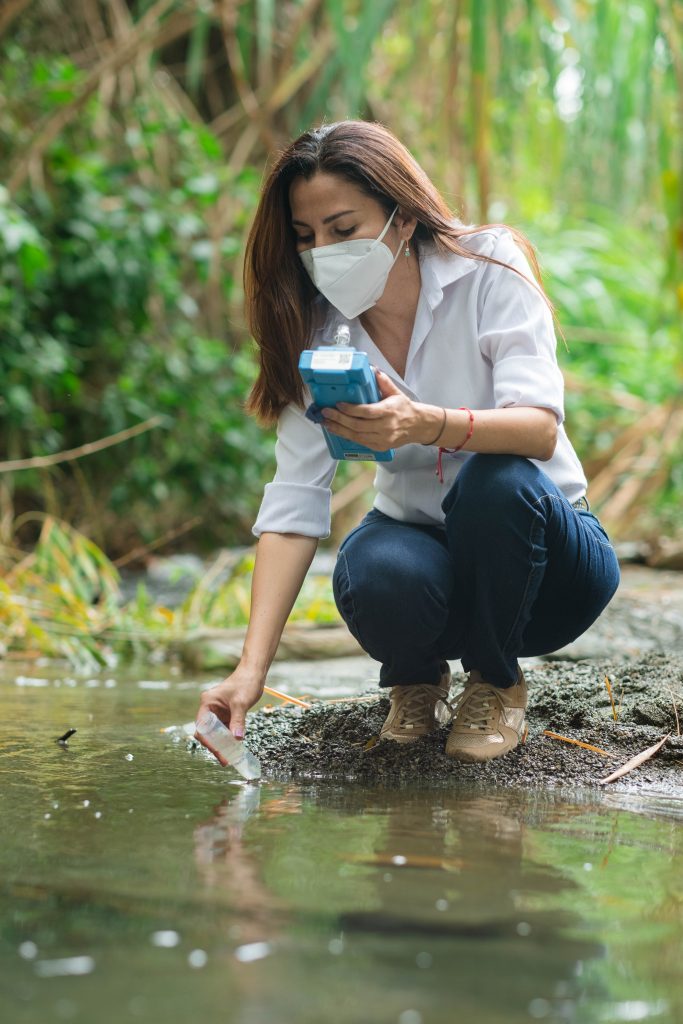22nd March 2021

Careful water management is imperative for a sustainable sugarcane sector. Bonsucro is committed to working with its members to ensure that water is available where it’s needed and that it helps to maintain rather than damage local ecosystems. This World Water Day, we look at what some of our members are doing to manage water sustainably across the world.
India
What is the project?
Meetha Sona Pariyojana is a sustainable sugarcane cultivation project managed by DCM Shriram Ltd in India. It aims to enhance productivity, conserve water resources and improve soil health in sugarcane cultivation. The project is run across the sugarcane catchment areas of all four sugar mills of DCM Shriram in Lakhimpur Khiri and Hardoi of Uttar Pradesh districts.
What prompted the project?
Smallholder farmers in DCM Shriram’s sugarcane-catchment-area used to have low farm-yields compared to sugarcane farmers in other parts of the state and the country. Low farm-yields were a result of low technical knowledge of sugarcane cultivation, limited access to technology and unsustainable input-usage, such as over-application of fertilizers and water. This led to an increase in the cost of cultivation without a yield increase. In addition, farmers were adopting non-climate-smart practices like crop-residue burning and over-irrigation.
DCM Shriram felt it was important to educate farmers to increase the yield of crop by adopting water conservation practices and suitable good agronomic practices.
Solution
DCM Shriram Ltd has developed a robust system for farmers capacity-building for sustainable yield improvements through adoption of climate-smart agronomy-package-of-practices. The project is named ‘Meetha Sona Pariyojana’ which translates from Hindi to sweet-gold.
What was done?
An eight-step approach has been adopted which includes the following:
- Need assessment: This was done by identifying gaps and opportunities and a baseline or diagnostic study
- Custom package of practices: A locally appropriate package of practices including water-use efficiency, soil health enhancement was developed considering the agro-climatic and the socio-economic status of the small farmers
- Capacity building: Training the trainer approach, intensive classroom and on-field training & feedback by sugar experts from reputed sugarcane research institutes
- Development of training manuals for farmers: Training manuals have been developed incorporating good agri practices for growers and extension staff.
- Lead farmers: To develop change agents, few select growers as lead farmers have been identified. Technology demonstration and exposure, mentorship & hand-holding are involved in developing them. Micro-entrepreneurship for mechanization is also propagated.
- Farmer training: Farmer training by extension workers, in-field expert advisory, technology demonstration
- Monitoring and evaluation: Field performance with crop cutting, Farmer’s knowledge attitude behavior survey, Cost-benefit analysis
- Scale and replication: Development results, Best practices /lessons
What are the objectives?
The project is based on essential training for smallholder farmers by expert scientists and field extension workers. The training modules included good agronomic practices for productivity, efficient water management practices including a Drip Irrigation System, soil health management focusing on increasing organic carbon content in soils, climate smart agronomic practices, integrated pest management including biological control of pests and gender inclusion.
What are the results?
Since the project began, 225,000 farmers were trained on good agricultural and water management practices. This has resulted in an average of 25% increase in yields across the catchment areas. In addition, over the past five years, more than 574 billion litres of water were saved – which has been certified by Indian Institute of Sugarcane Research, Lucknow. There has also been large scale adoption of trash mulching, press-mud comport and 19,700 compost pits have been laid out across the area.
Central America
What is the project?
In Central America, the World Wildlife Fund for Nature (WWF) has promoted the implementation of the Bonsucro standard to put the concept as sustainability into action in the sugar sector. At the sector level, in 2018, the Sustainability Guiding Principles Guide was developed in conjunction with the Association of Sugar Producers of Honduras (APAH) based on the criteria and principles of the Bonsucro standard and integrating national compliance indicators for the sector. Indicators related to water have been extremely important in the face of climate change.
What prompted the project?
Honduras is a developing country and vulnerable to climate change. The sugar sector faces continuous challenges every day, mainly those related to maintaining productivity and sustainability in the face of the effects of extreme events, linked to water resources. The scarcity or abundance of water (droughts or floods) have negative effects on productivity, proliferation of pests and diseases, social conflicts, among others.
What was done?
APAH, with support from WWF, developed a strategy from the water security perspective through integrated watershed management, to encourage sugar mills to contribute to the conservation of water recharge zones and important areas to ensure the continuity of the resource. Water for its production processes and reduce the effects of climate variability. As expressed by Gerardo Guillén, Executive Director from APAH: “this is a synonymous of sustainable development due to the good environmental practices and efforts that are being promoted.”
The sugarcane sector sustainability strategy in Honduras works to identify the watersheds of hydrological units associate with the sugar sector. Then, strengthen capacities for integrated watershed management in sugar mills. It also promotes research on the watersheds linked to the sector. There is also participation in governance of water resources at the watershed level. Finally, there is also a focus on conservation, restoration, management, protection of natural resources (forest and soil) and climate resilience in the watersheds that supply the sector with water resources.

What are the results?
Within the framework of World Water Day, it is important to reflect that in the face of the pressing challenges posed by climate variability in developing and highly vulnerable countries, the sugar sector plays an extremely important role. This role is relevant for sustainability, but also for creating resilience to climate change through the conservation of nature-based solutions in river watersheds to maintain a balance between nature and society. This is essential to increase the resilience of the sector and local communities, as well as to ensure the global production of this important sector.
Colombia
What is the project?
Through Cenicaña, the Colombian sugarcane agribusiness, conducts research on the conservation and recovery of the water supply. The project monitors the supply and demand of water, as well as increase the efficiency of use from the upper part of the basins to the mill factories. The project spans the south of the department of Risaralda to the north of the department of Cauca.
What prompted the project?
Cenicaña believes it is important to understand and quantify the relationship between the actions carried out by agribusiness and their impact. Resources are not abundant, so investments must be effective. The project aims to regulate the bodies of water present in the benefited area, to maintain the flows necessary for the supply of drinking water, agricultural and industrial use, and for the conservation of biodiversity.
What was done?
For more than twelve years, the sugarcane agribusiness has worked to protect, improve and conserve the ecosystems in 26 basins of the tributary rivers of the Cauca River within areas of sugarcane cultivation. A scientific base was established to understand the impacts on the quantity, water quality and sediment transport (loss of soil) in the intervened areas.
These actions include isolation for the protection of riparian forests, water sources and moors, as well as the establishment of silvopastoral systems and biological mini-corridors which have been carried out within the framework of the Fundación Fondo Agua por la Vida sector initiative.

Of the 26 basins in the project, a validation zone was taken in 2014 in the Bolo river basin to carry out socioeconomic, biodiversity and hydrological monitoring and understand the scale to which they are being impacted.
For the hydrological monitoring, areas of similar characteristics with and without interventions (paired basins) are compared, where flow measurements and total suspended solids (sediments) are made every 15 minutes through automated hydrometric stations in five basins to compare the response in water regulation and physical quality (loss of soil in the stream). Equipment is used to measure meteorological variables such as precipitation, relative humidity, air temperature, and solar radiation that intercede in the rain-flow relationship and therefore in the water balance of the zones.
What are the objectives of your project?
Cenicaña seeks to monitor the impacts on water quantity and quality of the conservation and recovery actions on water and soil implemented in the basins influenced by sugarcane cultivation, in order to obtain scientific evidence and guide investment.
What are the results?
The sugarcane agribusiness has collaborated with partners to protect, improve, and conserve soil and water in 26 basins, with 29 municipalities and more than 850,000 hectares of land. The land covers flat area wetlands to more than 1,300 msnm above the basin in the strategic ecosystems of paramo, sub-paramo, high Andean forest, sub-Andean forest and dry forest.
The socioeconomic monitoring showed that trust has been generated between the inhabitants of the upper part of the basins, the sugar industry and programme partners. There is recognition that local community organisations are vital to protect the conservation process – as is the case of water use associations, who maintain permanent relationships with indigenous councils, aqueduct boards, local producer associations, community action boards, among others.
The hydrological monitoring in the pilot zones shows a better hydrological response in the protected areas. After protections were established, the maximum flows observed showed a decreased in the amount of soil loss and soil dragging. Likewise, they show more stable flows in the dry season, contrasting with unprotected areas where the water balance of the zones has shown an increase in surface runoff, reducing the contribution of the upper zone (mountainous block) to underground storage, generating unfavourable conditions for the availability of water in the flat zone at the time dry.





